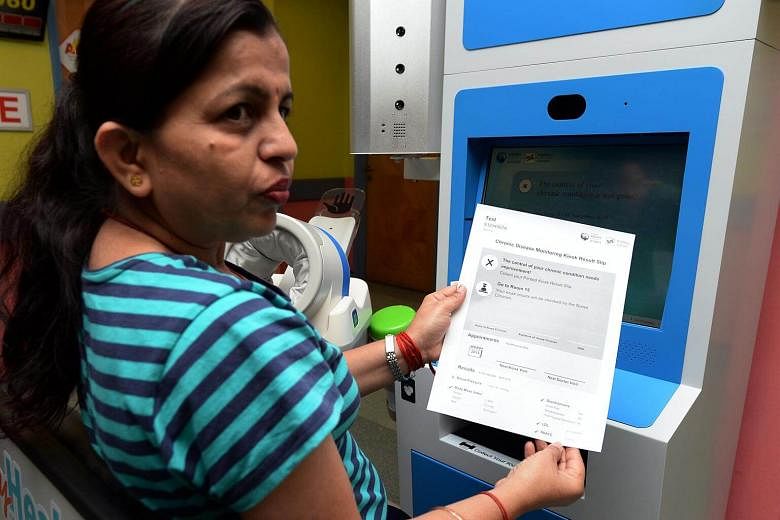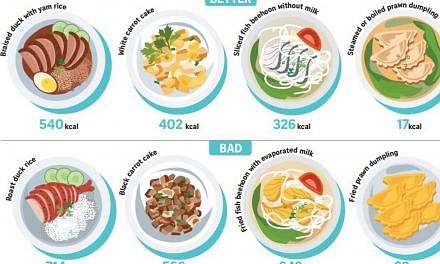People talk of counting calories to lose weight, but is it really as simple as that?
And how good a measure of overall health is one's body mass index (BMI) score, given that a professional athlete can be in tip-top shape and still be categorised as overweight?
Those who have attempted a new fitness or dieting regime may have grappled with these questions at some point in time.
The topic came under the spotlight in recent months, when the Health Promotion Board (HPB) released study findings showing that the median BMI had gone up over the past 15 years.
Worse, it found that Singaporeans these days are more likely to consume calories that they do not need.
And even though people are exercising more, this is not enough to offset the potential weight gain.
-
22.23
Singaporeans' median BMI in 2001.
23.15
Singaporeans' median BMI in 2016.
ALL CALORIES ARE NOT EQUAL
The HPB's efforts to help people identify healthier meals have typically centred on the number of calories in common foods.
But what exactly is a calorie? And how do 100 calories from sugar differ from 100 calories from leafy green vegetables?
The truth is that, from a strictly theoretical standpoint, both are no different, say the experts. A calorie is a unit of energy and its source does not change that.
But our bodies are not machines and foods are more than just their caloric content. This means that it does matter where we get our calories from.
"Looking only at calories ignores the metabolic effects of each calorie," said Dr Kalpana Bhaskaran, domain lead for applied nutrition and glycaemic index research at Temasek Polytechnic.
"Counting calories alone doesn't work because, ultimately, it matters where those calories come from. This matters more than the number of calories ingested."
-
WHAT IS A CALORIE?
Calories are units of energy that are used to estimate the energy value of food.
The term "kilocalorie" is often used interchangeably with "calorie". What is the difference?
One kilocalorie (kcal) is equivalent to 1,000 calories.
When people talk about food, they often use Calorie - with a capital C.
One "large" calorie is the same thing as one kcal.
However, the capital letter is often dropped for convenience, which can lead to confusion.
In some countries, nutrition labels may also state the energy value of foods in kilojoules instead.
One kcal is equivalent to approximately 4.2 kilojoules.WHAT IS THE CALORIE CONTENT OF DIFFERENT FOODS?
1g of fat: 9 kcal
1g of carbohydrates: 4 kcal
1g of protein: 4 kcal
1g of alcohol: 7 kcalWHAT IS OUR DAILY RECOMMENDED CALORIE INTAKE?
It is recommended that men consume no more than 2,200 kcal a day, and women, 1,800 kcal.
However, these numbers may vary, depending on the individual's age or lifestyle.
A person who has a sedentary office job, for example, may not need quite as much energy.
For example, sugar is just "empty calories", providing energy to the body, but not much else.
In fact, sugar can cause one's blood sugar levels to spike, which, in turn, raises insulin levels. Too many of these spikes and one's chances of diabetes are increased.
Vegetables, on the other hand, contain more than just calories. They are packed with antioxidants, fibre and other nutrients.
Most have a low glycaemic index, meaning that they are broken down slowly and do not cause large fluctuations in blood sugar levels.
Different foods have different calorie content.
Generally speaking, proteins and carbohydrates contain 4 calories per gram. In contrast, each gram of fat contains 9 calories.
Dr Osama Hamdy, a professor at Harvard Medical School, also stressed that it is the foods one eats - rather than the absolute number of calories consumed - that contribute most to obesity.
"What tends to cause obesity is the consumption of too much carbohydrates, especially sugar, wheat flour and starch, and the decrease in physical activity," said the senior endocrinologist.
Other factors, such as stress and the lack of sleep, may also influence how your body responds to the food you eat.
GOING BEYOND BMI
According to the HPB's findings, obesity rates have gone up by 0.7 percentage point a year between 2004 and 2010.
As of 2010, around 11 per cent of the population was obese. Last year, the median BMI was 23.15, up from 22.23 in 2001.
But what exactly is BMI and how good a measure is it of our overall health?
BMI provides a simple measure of body fat by comparing weight against height. For Asians, who tend to have more body fat than Westerners, a BMI score of 23 and above is considered outside of the healthy range.
Yet, it is possible for a muscular person to have a high BMI, or someone with a healthy BMI to actually have too much body fat.
This means that BMI is a useful tool for screening large groups of people, but less so when applied to individuals.
To get a more accurate picture of the risks related to their weight, people should also know their body fat percentage and waist circumference.
Dr Kalpana added: "Some of the routine blood tests - such as those that measure glucose levels - will help to complement BMI."








